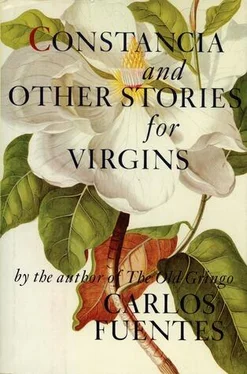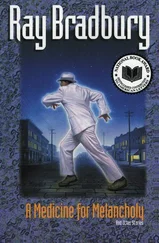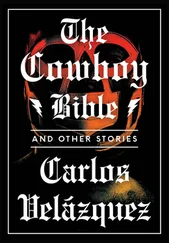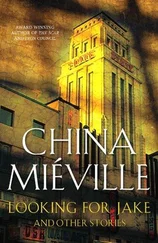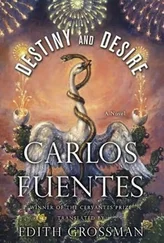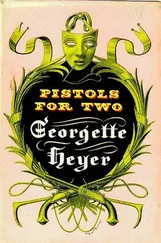— Architecture’s destiny is ruin, he repeated. The walls will crumble and anything will be able to pass through them, the air, a look, a dog … or the velocitous Vélezes.
As for us, sitting in the Lincoln having lunch with Santiago Ferguson, we saw a more subtle resemblance, our resemblance to Ferguson, our teacher; it wasn’t a physical similarity — he was fair, we were dark, he was balding, we had thick hair — it was more that we imitated him. We are formed not merely by our ancestors but by our contemporaries, especially our teachers, who are studied, admired, and respected by us. Our Indian blood was obvious in our dark complexions, while Ferguson was but a third-generation Mexican. His ancestors were part of that small wave of Scottish, Irish, and English immigrants who came to Mexico at the turn of the century, armed with surveyor’s tools, blueprints, and cases of whiskey, to build our bridges and railroads. They easily adapted to their new lives, married Mexican women; they stopped feeling homesick as soon as they found out that, among us, Galicians had a monopoly on bagpipes; they never switched from whiskey to cider, but they did change their baptismal names — James became Santiago: a militant Apostle, a soldier, a Moor-slayer instead of a tender young Apostle, the companion of Jesus, Santiago the Lesser — and nobody wore kilts anymore (except for a doll Catarina played with as a child; the Scottish skirt persisted, but they put it on a girl). Santiago Ferguson, who could have been James, from a family of engineers, studied in Britain, but while he was there he had a revelation: what impressed him was not the iron of bridges and trains but the gilded stone of the cathedrals.
— English cathedrals are the best-kept secret of Europe, he often said during the course of our lunches, sometimes almost obsessively wrinkling his forehead and squinting his restless little brown eyes. — No one goes to see them because England is no longer Catholic; for the Catholic tourist, going to Salisbury or York is like entering a den of heretics; and this prejudice has spread since the Middle Ages became the monopoly of Rome. We forget that English architecture still has a primeval quality, it’s like returning to our origins, it inspires awe in a way that Bruges or Rheims never can, because they are the product of a strictly formal Catholicism. The English cathedral is entirely different: it asks us to dare to go back to being Catholic, to rebel toward the sacred, to abandon the dreadful secular life that was supposed to bring us happiness but only brought us horror.
And then he would say, in a serious voice:
— I like the religious secret of my old islands. I would like to be buried in an English cathedral. I would go back there in rebellion, in affirmation of the sacred, the incomprehensible.
Gradually, we began to adopt his mannerisms — the way he arranged his napkin in his lap, for example; his movements — the self-conscious way he bent his head to clinch an argument, conveying an element of doubt, a horror of dogma, even the rejection of the very conclusion he was asserting; his irony, the feigned shock, the exaggerated open mouth, when someone proposed a belated discovery of the Mediterranean; his humor, his taste for the practical joke in the British style (what the Spanish call broma pesada ): he would pretend a classmate was getting married, invite us to the wedding; when we got there, amid the laughter, there would be a celebration going on all right, but not of an alarming marriage, rather of our same old comfortable friendship; the fraternity of celibates that could be our camaraderie, in which we shared the discipline of the lecture hall, the apprenticeship, the examination, the imagination. Another of his jokes was always to refer to his enemies in the past tense, as dead and gone (“the late critic X; the architect Y, who in his lifetime perpetrated such-and-such an atrocity; the celebrated architect Z, whose work, unfortunately, is ugly, but, fortunately, is destined to perish…”). He had no patience, basically — with pretentiousness, with lack of discipline and of punctuality, with the worship of money or its opposite, the cryptogenteel pretense of scorn for it: any lack of authenticity was anathema to him. But he didn’t confuse sincerity with the absence of mystery. We ate with him and he told us that our ancestors could be our ghosts but that we are the ghosts of our teachers, the same way the reader, in a certain sense, is the ghost of the author who is being read: I, ghost of Machen; you, ghost of Onions; he, ghost of Cortázar; we, ghosts of …
There are no empty houses, he said on one occasion, remember that … He sometimes imagined ghosts that were jokers, a lot like him, the professor, often so playful. He had invited us to so many weddings that when he told us about his daughter Catarina’s, we thought it would be one more joke, a cruel one, but still a joke. Deep down inside, we were convinced that he had kept her from us, that was why he had perversely agreed to meet us in his office that afternoon, knowingly (or not?), the afternoon of the steam and the tiles, and the frogs, of the girl enjoying herself. Perhaps he knew this would excite us even more. But now here we were, just like Professor Ferguson and, by extension, his daughter, tall, dark, and proud, holding her head as high as ever as she walked toward the nave of the Church of the Holy Family on the arm of her father the architect, dressed in a white gown that we had helped her choose in an old seamstress’s shop downtown, where they still make those old marvels, a Swiss-organdy dress with English embroidery — as the seamstress said, as modest as she was expensive, a gossamer veil that would have floated away if it hadn’t been weighted down with jewels and beads, and a full, heavy skirt that dragged on the ground, that we would have carried with pleasure, two mere attendants to our putative, unattainable bride, so much like us — dark, with flashing eyes and hair pulled back — who was approaching the altar to be joined to that chubby little lawyer, half freckled, half tan, who shook his little coffee-colored head with the satisfaction of a eunuch who’s been made to think he’s a stud.
That’s how we saw her, so different from her father (except that they were both tall), and we thought of the dead mother of our impossible lover; we looked at her and it struck us that there had never been a single photograph of the late Mrs. Ferguson in the professor’s house in the Pedregal, and, on top of that, he never mentioned her in conversation. Perhaps the combination of these things allowed us to give our imagination free rein. Catarina’s mother, who was not present at her daughter’s wedding, was dark like her, but dead, we decided. Catarina’s mother: unmentionable, clamorously mute. What would she, that gaping void, have thought of her son-in-law, Joaquín Mercado, the orange-complexioned groom? It was enough to make us want to speak for her, saying:
— Carlos María, you know, that speckled piece of shit isn’t the man we saw Catarina screwing in the bathroom.
— Don’t get excited, José María. Better think about the little porcelain frogs.
— As the professor says: Well, what can you do?
— I don’t think Catarina is ever going to be ours, brother.
5
We appreciated the fact that the place where we met for lunch with the professor turned out to be close to the place we worked, the busy area just south of the old, crowded avenue of San Juan de Letrán (which is now called Eje Lázaro Cárdenas), where several construction projects were going on at the same time: the metro was being expanded, the buildings damaged in the 1985 earthquake were being torn down, new green spaces were being created, historic buildings preserved, and a parking garage big enough for three hundred cars was being built — an urban smorgasbord that had turned those twenty-odd blocks in the center of the city into a combat zone.
Читать дальше
